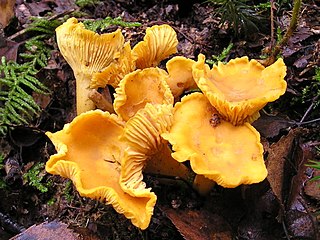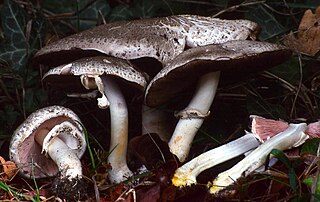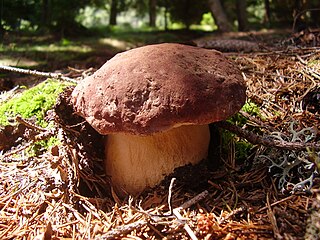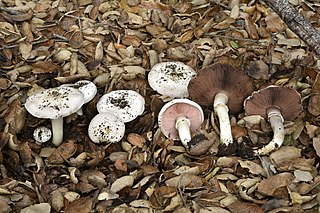
Edible mushrooms are the fleshy fruit bodies of several species of macrofungi. Edibility may be defined by criteria including the absence of poisonous effects on humans and desirable taste and aroma. Edible mushrooms are consumed for their nutritional and culinary value. Mushrooms, especially dried shiitake, are sources of umami flavor.

Chanterelle is the common name of several species of fungi in the genera Cantharellus, Craterellus, Gomphus, and Polyozellus. They are among the most popular of wild edible mushrooms. They are orange, yellow or white, meaty and funnel-shaped. On the lower surface, underneath the smooth cap, most species have rounded, forked folds that run almost all the way down the stipe, which tapers down seamlessly from the cap. Many species emit a fruity aroma, reminiscent of apricots, and often have a mildly peppery taste. The name chanterelle originates from the Greek kantharos meaning "tankard" or "cup", a reference to their general shape.

Cantharellus is a genus of mushrooms, commonly known as chanterelles, a name which can also refer to the type species, Cantharellus cibarius. They are mycorrhizal fungi, meaning they form symbiotic associations with plants. Chanterelles may resemble a number of other species, some of which are poisonous.

Mushroom hunting, mushrooming, mushroom picking, mushroom foraging, and similar terms describe the activity of gathering mushrooms in the wild. This is typically done for culinary use, although medicinal and psychotropic uses are also known. This practice is popular throughout most of Europe, Australia, Asia, as well as in the temperate regions of Canada and the United States.

Boletus edulis is a basidiomycete fungus, and the type species of the genus Boletus. Widely distributed in the Northern Hemisphere across Europe, Asia, and North America, it does not occur naturally in the Southern Hemisphere, although it has been introduced to southern Africa, Australia, New Zealand, and Brazil. Several closely related European mushrooms formerly thought to be varieties or forms of B. edulis have been shown using molecular phylogenetic analysis to be distinct species, and others previously classed as separate species are conspecific with this species. The western North American species commonly known as the California king bolete is a large, darker-coloured variant first formally identified in 2007.

Cantharellus cibarius is a species of golden chanterelle mushroom in the genus Cantharellus. It is also known as girolle. Despite its characteristic features, it may resemble at least one poisonous species.

Agaricus moelleri, commonly known as the flat-top agaricus, inky mushroom, or dark scaled mushroom, is a large mushroom of the genus Agaricus. It appears occasionally in most kinds of woodland, during late summer, in northern temperate zones.

Rubroboletus pulcherrimus—known as Boletus pulcherrimus until 2015—is a species of mushroom in the family Boletaceae. It is a large bolete from Western North America with distinguishing features that include a netted surface on the stem, a red to brown cap and stem color, and red pores that stain blue upon injury. Until 2005 this was the only bolete that has been implicated in the death of someone consuming it; a couple developed gastrointestinal symptoms in 1994 after eating this fungus with the husband succumbing. Autopsy revealed infarction of the midgut.

Boletus barrowsii, also known in English as the white king bolete after its pale colored cap, is an edible and highly regarded fungus in the genus Boletus that inhabits western North America. Found under ponderosa pine and live oak in autumn, it was considered a color variant of the similarly edible B. edulis for many years.

Boletus pinophilus, commonly known as the pine bolete or pinewood king bolete, is a basidiomycete fungus of the genus Boletus found throughout Europe and western Asia. Described by Italian naturalist Carlo Vittadini in 1835, B. pinophilus was for many years considered a subspecies or form of the porcini mushroom B. edulis before genetic studies confirmed its distinct status. In 2008, B. pinophilus in western North America were reclassified as a new species, B. rex-veris. B. pinophilus is edible, and may be preserved and cooked.

Leucoagaricus leucothites, commonly known as the smooth parasol, woman on motorcycle, ma'am on motorcycle, white dapperling, or white agaricus mushroom, is a species of agaric fungus. The species was originally described as Agaricus leucothites by Carlo Vittadini in 1835, and bears similarity to species of that genus. Solomon Wasser transferred it to Leucoagaricus in 1977. While sometimes regarded as edible, the species is suspected of being poisonous due to gastric-upset-causing toxins. It could also be confused with the deadly Amanita ocreata.

Clathrus ruber is a species of fungus in the family Phallaceae, and the type species of the genus Clathrus. It is commonly known as the latticed stinkhorn, the basket stinkhorn, or the red cage, alluding to the striking fruit bodies that are shaped somewhat like a round or oval hollow sphere with interlaced or latticed branches. The fungus is saprobic, feeding off decaying woody plant material, and is often found alone or in groups in leaf litter on garden soil, grassy places, or on woodchip garden mulches. Although considered primarily a European species, C. ruber has been introduced to other areas, and now has a wide distribution that includes all continents except Antarctica. The species was illustrated in the scientific literature during the 16th century, but was not officially described until 1729.

Polyozellus is a fungal genus in the family Thelephoraceae, a grouping of mushrooms known collectively as the leathery earthfans. Previously considered a monotypic genus, it now contains the Polyozellus multiplex species complex. The genus name is derived from the Greek poly meaning many, and oz, meaning branch. It is commonly known as the blue chanterelle, the clustered blue chanterelle, or, in Alaska, the black chanterelle. The distinctive fruit body of this species comprises blue- to purple-colored clusters of vase- or spoon-shaped caps with veiny wrinkles on the undersurface that run down the length of the stem.

Agaricus arorae is a moderate-sized, forest-dwelling mushroom that exhibits distinctive color changes. It fruits early in the mushroom season. Unusually within the genus Agaricus, the mushroom's cap cuticle turns yellow when exposed to a base such as potassium hydroxide or sodium hydroxide but stains red when cut. In the field, it has a brownish, fibrillose/squamulose cap, which turns red when bruised. Agaricus arorae was first described from Santa Cruz County but since has been found in San Mateo and Alameda counties. Agaricus arorae can be distinguished by its scales and a conspicuous stipe.

Boletus regineus, commonly known as the queen bolete, is an edible and highly regarded fungus of the genus Boletus that inhabits southwestern North America. It was considered a variant of the similarly edible B. edulis for many years until declared a unique species in 2008. Phylogenetic analysis has shown B. regineus as a member of a clade, or closely related group, with B. subcaerulescens, Gastroboletus subalpinus, B. pinophilus, B. fibrillosus, and B. rex-veris.

All That the Rain Promises, and More... is a wild mushroom identification and field guide by American mycologist David Arora and published in 1991 by Ten Speed Press in Berkeley, California. The book includes detailed descriptions of more than 200 edible and poisonous mushroom species, as well as recipes, stories, and information on uses of various species such as for dying hair and clothing or playing games. In the preface, Arora writes, "In leafing through these pages, you may wonder what all the 'fanciful,' 'foolish,' or (shudder) 'extraneous' material is doing in a factual guide. After all, it is the practical, hands-on, how-to-identify information that makes this book useful and gives it substance. But I ask: is it any stranger or less desirable to sprinkle the facts with flakes of fancy than it is to liven up solemn, substantial fare like potatoes with something fancier and more flavorful, like wild mushrooms?"

Lactarius rufulus, commonly known as the rufous candy cap, is a species of fungus in the family Russulaceae. The fruit bodies have fleshy brownish-red caps up to 10 cm (3.9 in) wide, and closely spaced pinkish-yellow gills. The stem is up to 12 cm (4.7 in) long and 3 cm (1.2 in) thick and colored similarly to the cap. The species, known only from California, Arizona, and Mexico, grows on the ground in leaf litter near oak trees. The fruit bodies resembles those of L. rufus, but L. rufulus tends to grow in clusters at a common base, rather than solitarily or in groups. A distinguishing microscopic characteristic is the near absence of large, spherical cells called sphaerocysts that are otherwise common in Lactarius species. Lactarius rufulus mushrooms are edible, and have an odor resembling maple syrup. They have been used to flavor confections and desserts.

Agaricus californicus, commonly known as the mock meadow mushroom, or California agaricus, is a poisonous mushroom in the section Xanthodermati of the genus Agaricus.

Cantharellus subalbidus, the white chanterelle, is a fungus native to California and the Pacific Northwest region of North America. It is a member of the genus Cantharellus along with other popular edible chanterelles. It is similar in appearance to other chanterelles except for its cream to white color and orange bruising.

Cantharellus californicus, also called the California golden chanterelle, mud puppy, or oak chanterelle, is a fungus native to California, United States. It is a member of the genus Cantharellus along with other popular edible chanterelles. It is generally similar in appearance to C. cibarius and C. formosus except for its large size at maturity; individual specimens larger than 1 kilogram (2.2 lb), or greater, are reported, making it the largest known species of chanterelle. Their unusual size is due in part to their capacity for indeterminate growth, making Cantharellus californicus specimens actively grow for far longer than most other mushrooms. It became the official state mushroom of California in 2024.




















